All About Telecommunications Line Installers and Repairers
Job Description & Duties Install and repair telecommunications cable, including fiber optics.
Telecommunications Line Installer or Repairer Responsibilities
- Compute impedance of wires from poles to houses to determine additional resistance needed for reducing signals to desired levels.
- Explain cable service to subscribers after installation and collect any installation fees that are due.
- String cables between structures and lines from poles, towers, or trenches and pull lines to proper tension.
- Use a variety of construction equipment to complete installations, such as digger derricks, trenchers, or cable plows.
- Access specific areas to string lines or install terminal boxes, auxiliary equipment, or appliances, using bucket trucks, or by climbing poles or ladders, or entering tunnels, trenches, or crawl spaces.
- Set up service for customers, installing, connecting, testing, or adjusting equipment.
Featured schools near , edit
Telecommunications Line Installer or Repairer Skills
When polled, Telecommunications Line Installers and Repairers say the following skills are most frequently used in their jobs:
Operation Monitoring: Watching gauges, dials, or other indicators to make sure a machine is working properly.
Speaking: Talking to others to convey information effectively.
Critical Thinking: Using logic and reasoning to identify the strengths and weaknesses of alternative solutions, conclusions or approaches to problems.
Complex Problem Solving: Identifying complex problems and reviewing related information to develop and evaluate options and implement solutions.
Active Listening: Giving full attention to what other people are saying, taking time to understand the points being made, asking questions as appropriate, and not interrupting at inappropriate times.
Judgment and Decision Making: Considering the relative costs and benefits of potential actions to choose the most appropriate one.
Types of Telecommunications Line Installer or Repairer Jobs
- Cableman
- Broadband Technician
- Telecommunications Technician
- Cable Layer
- Cable Systems Installer
Is There Going to be Demand for Telecommunications Line Installers and Repairers?
In 2016, there was an estimated number of 106,100 jobs in the United States for Telecommunications Line Installer or Repairer. New jobs are being produced at a rate of 1.5% which is below the national average. The Bureau of Labor Statistics predicts 1,600 new jobs for Telecommunications Line Installer or Repairer by 2026. The BLS estimates 10,700 yearly job openings in this field.
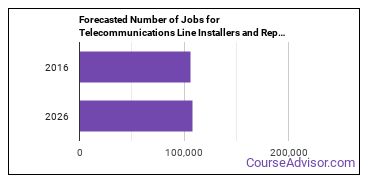
The states with the most job growth for Telecommunications Line Installer or Repairer are Nevada, Utah, and Tennessee. Watch out if you plan on working in Kansas, Vermont, or District of Columbia. These states have the worst job growth for this type of profession.
Average Telecommunications Line Installers and Repairers Salary
The typical yearly salary for Telecommunications Line Installers and Repairers is somewhere between $30,950 and $92,440.
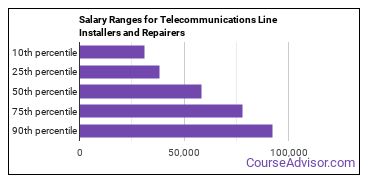
Telecommunications Line Installers and Repairers who work in New Jersey, Massachusetts, or New York, make the highest salaries.
Below is a list of the median annual salaries for Telecommunications Line Installers and Repairers in different U.S. states.
| State | Annual Mean Salary |
|---|---|
| Alabama | $42,940 |
| Alaska | $70,140 |
| Arizona | $50,800 |
| Arkansas | $56,520 |
| California | $66,200 |
| Colorado | $51,790 |
| Connecticut | $68,460 |
| Delaware | $73,920 |
| District of Columbia | $74,360 |
| Florida | $40,860 |
| Georgia | $43,120 |
| Hawaii | $66,430 |
| Idaho | $46,410 |
| Illinois | $57,400 |
| Indiana | $42,450 |
| Iowa | $52,460 |
| Kansas | $60,160 |
| Kentucky | $47,930 |
| Louisiana | $40,200 |
| Maine | $60,600 |
| Maryland | $65,060 |
| Massachusetts | $81,030 |
| Michigan | $46,280 |
| Minnesota | $45,420 |
| Mississippi | $49,370 |
| Missouri | $50,950 |
| Montana | $53,970 |
| Nebraska | $43,360 |
| Nevada | $41,700 |
| New Hampshire | $62,570 |
| New Jersey | $84,130 |
| New Mexico | $46,210 |
| New York | $72,840 |
| North Carolina | $44,740 |
| North Dakota | $62,740 |
| Ohio | $43,740 |
| Oklahoma | $56,350 |
| Oregon | $55,670 |
| Pennsylvania | $69,530 |
| Rhode Island | $60,040 |
| South Carolina | $54,320 |
| South Dakota | $49,710 |
| Tennessee | $44,290 |
| Texas | $52,220 |
| Utah | $48,620 |
| Vermont | $63,520 |
| Virginia | $61,070 |
| Washington | $64,440 |
| West Virginia | $59,350 |
| Wisconsin | $54,430 |
| Wyoming | $55,100 |
What Tools & Technology do Telecommunications Line Installers and Repairers Use?
Although they’re not necessarily needed for all jobs, the following technologies are used by many Telecommunications Line Installers and Repairers:
- Microsoft Excel
- Microsoft Word
- Microsoft Office
- Web browser software
- Email software
- Autodesk AutoCAD
- Customer relationship management CRM software
- Cisco IOS
Becoming a Telecommunications Line Installer or Repairer
What education is needed to be a Telecommunications Line Installer or Repairer?
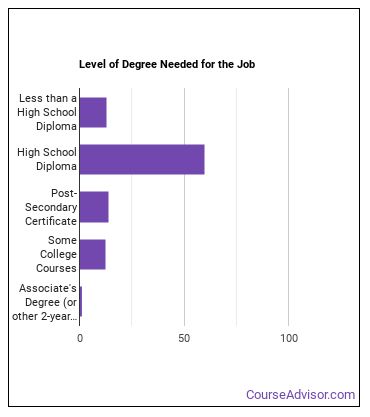
How Long Does it Take to Become a Telecommunications Line Installer or Repairer?
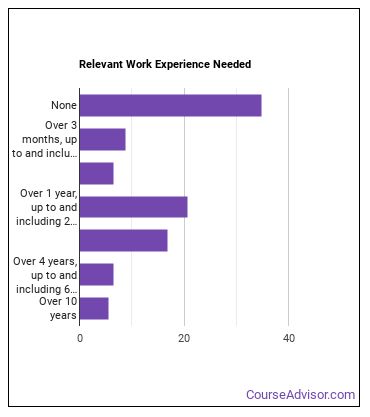
Telecommunications Line Installers and Repairers Sector
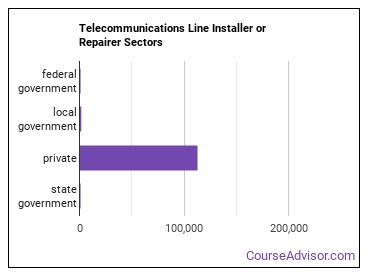
Below are examples of industries where Telecommunications Line Installers and Repairers work:
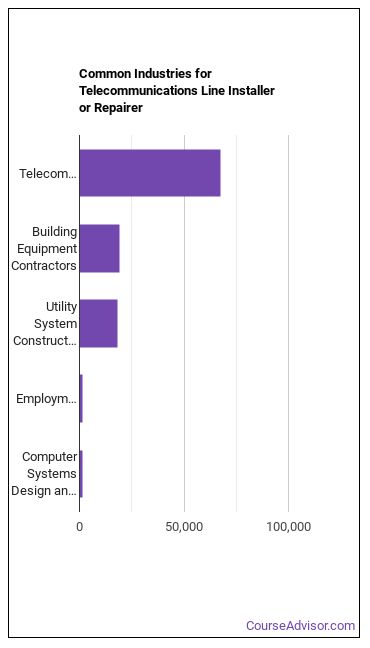
Similar Careers
Those thinking about becoming a Telecommunications Line Installer or Repairer might also be interested in the following careers:
- Cutting, Punching, and Press Machine Setters, Operators, and Tenders, Metal and Plastic
- Motorboat Operators
- Rotary Drill Operators, Oil and Gas
- Cooks, Restaurant
- Rail Yard Engineers, Dinkey Operators, and Hostlers
- Maintenance and Repair Workers, General
Those who work as a Telecommunications Line Installer or Repairer sometimes switch careers to one of these choices:
References:
Image Credit: Airman 1st Class Alexis P. Docherty, 49th Wing Public Affairs via Public domain
More about our data sources and methodologies.
Featured Schools
 Request Info
Request Info
|
Southern New Hampshire University You have goals. Southern New Hampshire University can help you get there. Whether you need a bachelor's degree to get into a career or want a master's degree to move up in your current career, SNHU has an online program for you. Find your degree from over 200 online programs. Learn More > |
